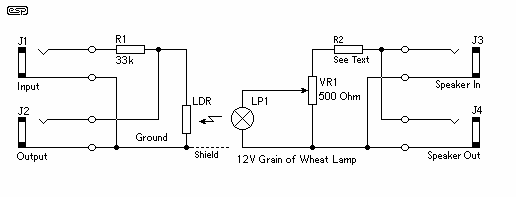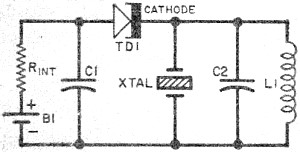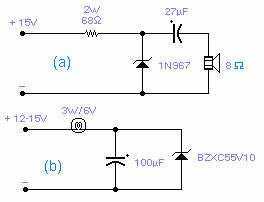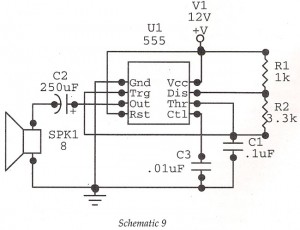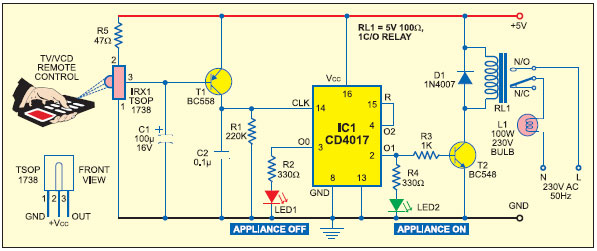
WAH & FUZZ Guitar circuits
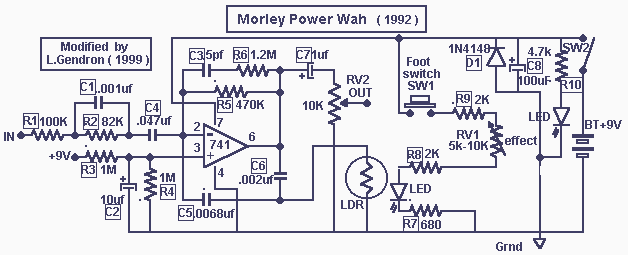
These two projects, Wah and Fuzz, are the results of a modification to a Morley dual channel volume control pedal that one of my sons suggested I undertake as he had no use for the volume unit but thought I could modify the pedal into a Wah unit. I decided later to add a Fuzz circuit and combine the two into a single switchable unit as described further on. Not being one to re-invent the wheel, I downloaded several circuits from the Internet and after breadboarding several I chose the original Morley circuit as it had the best sound and was using an LDR/LED control which simplified its construction. More: Using the phase shifting design with an op-amp sounds very close to the inductor type Wah circuit but with no up and down variation like the pedal allows. I concentrated on the triggering aspect of the LED/LCD to try and produce a varying attack and de.
The Wah and Fuzz pedal modification involves a dual-channel volume control circuit that has been creatively repurposed. The original Morley circuit, which utilizes a Light Dependent Resistor (LDR) and Light Emitting Diode (LED) for control, serves as the foundation for this project. The LDR responds to light changes from the LED, enabling a variable resistance that affects the audio signal, thus creating the characteristic Wah effect.
The Wah circuit operates on the principle of phase shifting, achieved through an operational amplifier (op-amp) configuration. This design mimics the sound of traditional inductor-based Wah pedals while providing a more straightforward construction process. The absence of the up-and-down variation typically found in traditional pedals is compensated by focusing on the modulation of the LED's brightness, which in turn alters the LDR's resistance.
The Fuzz circuit, added to the Wah design, allows for a rich distortion effect that can be engaged or disengaged via a switch. This integration of two effects into a single unit enhances versatility, making it suitable for various musical styles. The switchable aspect is crucial for live performances, allowing musicians to easily toggle between effects without needing multiple pedals.
Overall, the combined Wah and Fuzz circuit provides a unique audio processing tool that leverages existing technologies while allowing for personal modification and enhancement. The careful selection of components and circuit design ensures both effects maintain high audio fidelity and usability, catering to the needs of guitarists seeking to expand their tonal palette.These two projects , Wah and Fuzz, are the results of a modification to a Morley dual channel volume control pedal that one of my sons suggested I undertake as He had no use for the volume unit but thought I could modify the pedal into a Wah unit. I decided later to add a Fuzz circuit and combine the two into a single switchable unit as described further on.
Not being one to re-invent the wheel, I downloaded several circuits from the Internet and after breadboarding severals I chose the original Morley circuit as it had the best sound and was using an LDR/LED control which simplified its construction. Using the phase shifting design with an op-amp sounds very close to the inductor type Wah circuit but with no up and down variation like the pedal allows . I concentrated on the triggering aspect of the LED/LCD to try and produce a varying attack and de 🔗 External reference
The Wah and Fuzz pedal modification involves a dual-channel volume control circuit that has been creatively repurposed. The original Morley circuit, which utilizes a Light Dependent Resistor (LDR) and Light Emitting Diode (LED) for control, serves as the foundation for this project. The LDR responds to light changes from the LED, enabling a variable resistance that affects the audio signal, thus creating the characteristic Wah effect.
The Wah circuit operates on the principle of phase shifting, achieved through an operational amplifier (op-amp) configuration. This design mimics the sound of traditional inductor-based Wah pedals while providing a more straightforward construction process. The absence of the up-and-down variation typically found in traditional pedals is compensated by focusing on the modulation of the LED's brightness, which in turn alters the LDR's resistance.
The Fuzz circuit, added to the Wah design, allows for a rich distortion effect that can be engaged or disengaged via a switch. This integration of two effects into a single unit enhances versatility, making it suitable for various musical styles. The switchable aspect is crucial for live performances, allowing musicians to easily toggle between effects without needing multiple pedals.
Overall, the combined Wah and Fuzz circuit provides a unique audio processing tool that leverages existing technologies while allowing for personal modification and enhancement. The careful selection of components and circuit design ensures both effects maintain high audio fidelity and usability, catering to the needs of guitarists seeking to expand their tonal palette.These two projects , Wah and Fuzz, are the results of a modification to a Morley dual channel volume control pedal that one of my sons suggested I undertake as He had no use for the volume unit but thought I could modify the pedal into a Wah unit. I decided later to add a Fuzz circuit and combine the two into a single switchable unit as described further on.
Not being one to re-invent the wheel, I downloaded several circuits from the Internet and after breadboarding severals I chose the original Morley circuit as it had the best sound and was using an LDR/LED control which simplified its construction. Using the phase shifting design with an op-amp sounds very close to the inductor type Wah circuit but with no up and down variation like the pedal allows . I concentrated on the triggering aspect of the LED/LCD to try and produce a varying attack and de 🔗 External reference
